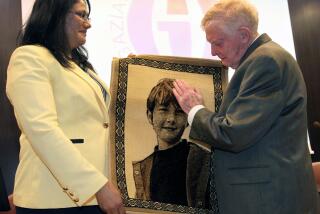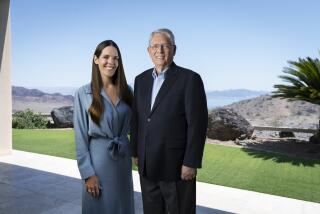Hard Choices in a Genetic Calamity
IONE, Calif. — When Tommy Bennett was born in September 1999, his parents were still trying to figure out what was wrong with his older sister, Ciara. She was slower than other children they knew. Was she hard of hearing? Or maybe autistic?
Last year, lab tests confirmed that Ciara had Sanfilippo syndrome, a genetic disease that kills most victims by their teenage years.
This February, the test results came back for John and Alicia Bennett’s other two children.
“It was like getting hit by lightning,” said Freda Bennett, John’s mother. “I was working in the garden when I heard my husband scream, ‘No, no, no!’ ”
Against all odds, John and Alicia Bennett of Amador County are watching a deadly disease disable all three of their children: Ciara, 6; Hunter, 4; and Tommy, who will turn 3 next month.
Their bodies lack an enzyme needed to break down chains of sugar molecules. Over time, these molecules are stored in cells and begin to build up, causing progressive organ damage. Sanfilippo affects just one in 70,000 children. And as with many rare diseases that don’t generate much interest from researchers or drug companies, there is no proven treatment or cure.
In June, the Bennetts’ insurer, Kaiser Permanente, denied their request for an experimental stem-cell transplant at Duke University. The Bennetts see that as their only hope. Although other insurers have covered the experimental treatment for Sanfilippo, Kaiser said the risk of dying from the transplant was too great, and that no published research indicated it would work.
The Bennett family’s story pits two parents’ desperate attempt to save their children against the realities of health-care economics.
“If we are going to hold costs down, some people are not going to get treatment that might--just might--work, and some people are going to die,” said Michael Shapiro, a law professor and ethicist at USC.
The Bennetts are hoping for a miracle. Reaching out to whoever will listen, they have called newspapers and appeared on television. They are trying to raise $1.5 million for transplants for Hunter and Tommy.
The couple said nothing will save Ciara; the disease has progressed too far.
Their close-knit community has rallied, as have supporters in neighboring Sacramento County and beyond. Earlier this month, the local American Legion lodge raised $10,000 at a dinner of tri-tips, pasta, salad and a make-your-own-sundae bar. The next day, an eighth-grade class collected nearly $2,400 at a carwash.
But so far, the Bennetts have only about $80,000. They worry that, if the pace of donations doesn’t pick up, they will have to choose which of the boys should undergo the procedure--a “Sophie’s choice” they are not prepared to make.
“If they’re both eligible, we have to decide: Do we try to save Hunter and keep raising money for Tom? Or do we try to help Tom, who has a better chance?” said Alicia Bennett, 34, who used to work as a receptionist at a hospital emergency room.
“We shouldn’t have to choose which kid can live.”
Progress OK, at First
When she was an infant, Ciara’s progress was “right on key,” her mother said. The baby began walking 10 months after her May 1996 birth, and started speaking at about a year.
But her speech was never quite right; she sounded as though she might be deaf. The Bennetts began taking Ciara to specialists.
“They all looked at me like I was crazy, but I know when there’s something wrong,” Alicia Bennett said.
In August 2000, a new special education teacher at Plymouth Elementary School took one look at Ciara’s picture and suggested to her colleagues that the youngster had Sanfilippo syndrome. The teacher, Lisa Rhody-Buttner, who had worked with another Sanfilippo child years earlier, recognized some telltale signs: puffy cheeks, coarse hair and big eyebrows.
Ciara was diagnosed with Sanfilippo in February 2001.
The day after last Christmas, doctors took skin biopsies from both boys, confirming two months later that they also had the disease.
“The doctors thought Hunter might, but nobody thought Tommy did,” their mother said.
“It felt like getting hit in the kidney,” said John Bennett, a 33-year-old trucker and volunteer firefighter, his voice trailing off.
The family had fared dismally in the genetic lottery. Unlike with other diseases that strike at random, both of a child’s parents have to carry a defective gene for a child to acquire Sanfilippo.
Even then, the chances are only 1 in 4 that such a couple’s child will have the disease. The chances of all three children being affected are 1 in 64.
John and Alicia Bennett said they know of no one else in their families who has had the disease.
The successive stages of Sanfilippo can be seen in the three children. Ciara’s vocabulary at one time was 200 words, but she no longer speaks. Her walking is unsteady, and she trips often. She can barely play with her brothers or with toys. She drools, and has already begun having seizures, a sign that the disease is progressing.
Hunter, whose hair is pumpkin orange, says a few words, but uses them sparingly. He walks and runs easily but often cries and pouts.
And Tommy seems like a typical toddler, although he has not started talking.
During a visit earlier this month to Disneyland, Ciara, dressed in a yellow “Princess University” shirt, chirped and moved her arms to signal her pleasure on the Pirates of the Caribbean ride. Hunter cried because he hates the dark. Tommy slept, his head resting on his mother’s shoulder.
This trip was intended to give everyone a rest. After leaving Mickey’s Toontown, Alicia Bennett bought the children sets of Mickey Mouse ears, embroidered with their names.
“I try not to think about it,” she said of the children’s fate. “I need a break from reality every now and then.”
Hope for Stem Cells
Days after the boys were diagnosed, their mother e-mailed Dr. Joanne Kurtzberg, director of the pediatric stem-cell transplant program at Duke University. Kurtzberg is one of the few researchers trying to find a treatment for Sanfilippo.
She believes that stem-cell transplants, using umbilical cord blood, may be able to stop its progression. The technique has worked for similar neurological diseases by replacing defective cells with healthy ones, and theoretically it could provide the enzyme that Sanfilippo patients lack.
Kurtzberg has transplanted stem cells from umbilical cord blood into four children with Sanfilippo in the last 18 months.
All are alive, but it’s too soon to tell whether any of the transplants were successful.
“There’s no question that this is the only therapy that offers these children any chance,” she said. “The alternative these kids face is death and horrible neurological degenerative disease.”
The entire Bennett family flew to North Carolina in March to meet with Kurtzberg and discuss the procedure.
But Kaiser Permanente, California’s largest insurer, has said it won’t cover the treatment. Dr. Mark Lipson, the insurer’s geneticist who treats the Bennett children, said the decision was personally difficult but was medically justified.
“The transplant offers no clear evidence that it will benefit them, but it does offer clear evidence that it will cause them severe pain, sickness and perhaps death,” Lipson said. “Those are very real risks.”
The transplant and chemotherapy beforehand obliterate the children’s bone marrow and the immune system, treatments that at least 10% of young children don’t survive.
An independent panel of three pediatric specialists hired by the California Department of Managed Health Care agreed unanimously with Kaiser’s decision.
But other insurers have agreed to take the chance. Athena Sarantinos of Seattle said her insurer, Premera Blue Cross, changed its mind after initially denying coverage for the procedure. Her 2 1/2-year-old son, Luke, received his transplant June 28.
She said family members had offered to sell their homes to raise money if her insurer didn’t come through. “We feel very privileged.... Now we have hope where there wasn’t any hope,” she said.
Citing members’ privacy, Premera spokesman Scott Forslund said that he couldn’t address the Sarantinos case, but that for the last two years his company has had a policy of covering cord-blood transplants for Sanfilippo.
Because the disease is so rare, he said, the insurer looks beyond published studies, clinical trials and national guidelines to make coverage decisions.
Ellen Bowman said her insurer, Blue Cross and Blue Shield of Alabama, similarly approved the procedure for her 6-year-old son, Andrew.
“We won’t know for a couple more years,” she said of Andrew’s prognosis after his May 2001 transplant.
‘Holding His Own’
“We just hope every day that he continues to talk, that he continues to walk and that he continues to be Andrew. And right now, he’s holding his own.”
Shapiro, the USC ethicist, said insurance companies should not necessarily be faulted for drawing the line at pursuing unproven procedures.
“If people want to keep a lid on health-care costs, society has to stop things at some point,” he said. But “in individual cases, it looks like it is horribly unjust.”
As the Bennetts’ story has become known, friends and strangers have reached out to help.
A room mother at St. John Vianney School in Rancho Cordova encouraged eighth-graders to hold a carwash for the Bennetts.
Despite the day’s 105-degree heat, cars were lined up for nearly six hours Aug. 11, raising nearly $2,400.
“Once I met the kids, I realized that we needed to do something about it,” said Eric Watson, 13, who helped his mother organize the event.
Elanora Drake, secretary of the auxiliary for American Legion Amador Post 108, said fund-raisers usually bring in $300 to $400. The $10,000 raised a month ago was “really unusual.”
“We cooked it all, served it all, cleaned up,” Drake said of the event, which drew 250 attendees. “This is a small community. People just get behind you.”
Malinda Goodman and her husband, Michael, donated two 10-day stays at their home in Bali to be used in a raffle.
“I told my husband, other than raising our son Samuel, I can’t think of anything more important or more worthwhile in my life than to take this on,” she said.
*
The Bennetts have set up a Web site soliciting donations for their children: www.helpachild.net. Donations also may be sent to the Bennett Children’s Fund, P.O. Box 1826, Jackson, CA 95642.






